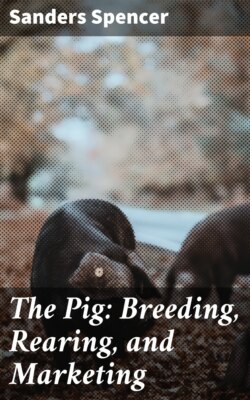Читать книгу The Pig: Breeding, Rearing, and Marketing - Spencer Sanders - Страница 11
На сайте Литреса книга снята с продажи.
CHAPTER II
PURE BREEDS
ОглавлениеTable of Contents
The task of writing a description of the various breeds of swine has been rendered less difficult by the formation during the past half-century of societies for the registration of the pedigrees of the pigs of the different breeds, and by the setting up of scales of those points which pigs for entry in the particular herd books should possess. The first of these societies was the National Pig Breeders Association, of which the present writer was the honorary secretary for two years. At the time of its formation the breeds of pigs most generally recognised were the Berkshire, the Large, Middle, and Small Whites or Yorkshires, and the Small Black breed. It was intended that the pedigrees of the pure bred pigs of each of these breeds should be recorded by the Association and published in one herd book.
There is no doubt that this would have been an ideal plan, and would have resulted in a saving of much labour and expense, and decidedly more convenient for those connected with the export trade. For reasons into which it is not now necessary to enter, the breeders of Berkshires determined to have a separate herd book; therefore, they started a society which they named the British Berkshire Society, to distinguish it from the American Berkshire Record.
Subsequently the Tamworth breed of pigs became recognised by the Royal Agricultural Society, and the breeders of the red pig joined the National Pig Breeders Association. Then the demand for Small White and Small Black pigs ceased, so that eventually the pedigrees of Large White, Middle White, and Tamworth pigs only were registered in the N.P.A. Herd Book.
Subsequently the breeders of Tamworth pigs formed themselves into a society presumably for propaganda work, and to conserve the interests of breeders of Tamworth pigs. Of late years other breeds of pigs have been brought to public notice, and have had herd books, and societies specially devoted to their particular interests. The Large Black, Large White Ulster, the Lincolnshire Curly Coated pigs, the Gloucestershire Old Spots, and the Cumberland pigs have their pedigrees recorded. An attempt was made some years since to resuscitate the Oxfordshire Spotted pig, but it was not a continued success. It is quite possible that other local breeds of pigs may find sufficient admirers to form societies to bring before the public the many good qualities possessed by the pigs of these breeds, but apart from local interest it is at least doubtful if any permanent benefit will supervene from this multiplication of herd books—save that it may increase the interest in pig breeding, a result devoutly to be prayed for.
The issuing of the scales of points of those breeds of pigs whose pedigrees are recorded in the various herd books has rendered it unnecessary for us to endeavour to formulate the good qualities which are presumably those which are more or less completely possessed by these pedigreed animals, nor does the necessity exist for us to mention those particular qualities which each breed is supposed by the admirers of other breeds to lack. There is no doubt that each breed possesses certain points which render it specially suitable for differing localities and varying purposes.
Some persons who look upon a pig solely as an animal, as a converter of various substances into pork, are of opinion that the tendency of those responsible for the running of these societies is towards fancy points to the detriment of the practical points. There appears to have been some grounds for this view. The Small White, the Small Black, the Berkshire, and the Large White have all been affected by the acts of faddists. The three first-named breeds suffered from the aims of certain of the breeders to reduce the size and to increase the so-called quality until the consumers of pork refused to follow the fashion; whilst the craze which has seriously affected the utility of the Large White pigs has been exactly the opposite, i.e. an endeavour to so vastly increase the size that they ceased to supply the kind of pork and the size of joints which the general public demanded. It may be natural for fanciers to declare that a Small White or a Small Black pig must be a small animal, but this is only on comparison with the large breeds of the same colour and characteristics. The usefulness of the pig in the commercial world must be studied if any breed of pig is to hold its own on the market.
The opposite extreme to that followed by the breeders of the small breeds is that of the breeders of Large Whites, who look upon mere size as the most important of the points to be studied. The mere increase in bulk, in length of head and leg and weight of bone may appeal to the mere fancier or faddist, but by paying undue attention to these fancy points the actual object of the breeding and fattening of pigs is lost sight of, and the consumer who is after all the one whose wants must first receive study, is estranged and the commercial market is lost.
In the following pages will be found full particulars together with the scales of points, as issued by the various societies, of the chief breeds and varieties.
